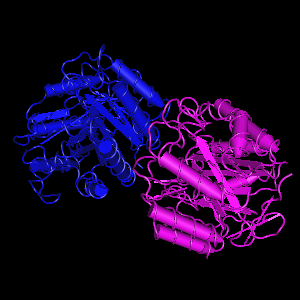Pseudoalteromonas haloplanktis: Difference between revisions
| Line 20: | Line 20: | ||
==Description and significance== | ==Description and significance== | ||
''Pseudoalteromonas haloplanktis'' is a curved, rod shaped (0.2 to 1.5 by 1.8 to 3 µm), Antarctica psychrophile bacterium (Gauthier ''et al''). It was initially called ''Alteromonas tetraodonis'', but has been reclassified as ''Alteromonas haloplanktis then to Pseudoalteromonas haloplanktis'' from the phylogenetic assays that was done by Gauthier ''et al.'' [http://ijs.sgmjournals.org/cgi/reprint/45/4/755.pdf Gauthier ''et al.'']. In addition, ''Pseudoalteromonas haloplanktis'' is a Gram negative bacterium that is non-spore-forming, not luminescent, and is motile by polar flagella. This organism was isolated from the Antarctic coastal sea sample water and is found to grow only in marine environment at ~20ºC. Researchers have sequenced some of its genome such as DNA ligase and cellulase to give an understanding of how its enzymatic proteins allow it to adapt at such low temperature. | ''Pseudoalteromonas haloplanktis'' is a curved, rod shaped (0.2 to 1.5 by 1.8 to 3 µm), Antarctica psychrophile bacterium (Gauthier ''et al''). It was initially called ''Alteromonas tetraodonis'', but has been reclassified as ''Alteromonas haloplanktis'' then to ''Pseudoalteromonas haloplanktis'' from the phylogenetic assays that was done by Gauthier ''et al.'' [http://ijs.sgmjournals.org/cgi/reprint/45/4/755.pdf Gauthier ''et al.'']. In addition, ''Pseudoalteromonas haloplanktis'' is a Gram negative bacterium that is non-spore-forming, not luminescent, and is motile by polar flagella. This organism was isolated from the Antarctic coastal sea sample water and is found to grow only in marine environment at ~20ºC. Researchers have sequenced some of its genome such as DNA ligase and cellulase to give an understanding of how its enzymatic proteins allow it to adapt at such low temperature. | ||
[[File:Cell morphology of Pseudoalteromonas haloplanktis- NIH.png|thumb|right|Cell morphology of bacterium [http://www.ncbi.nlm.nih.gov/Structure/mmdb/mmdbsrv.cgi?uid=1TVN NIH]]] | [[File:Cell morphology of Pseudoalteromonas haloplanktis- NIH.png|thumb|right|Cell morphology of bacterium [http://www.ncbi.nlm.nih.gov/Structure/mmdb/mmdbsrv.cgi?uid=1TVN NIH]]] | ||
Revision as of 23:11, 18 November 2012
A Microbial Biorealm page on the genus Pseudoalteromonas haloplanktis
Classification
Higher order taxa
Bacteria; Proteobacteria; Gammaproteobacteria; Alteromonadales; Pseudoalteromonadaceae; Pseudoalteromonas
Species
P. agarivorans, P. aliena, P. antarctica, P. arctica, P. atlantica, P. aurantia, P. byunsanensis, P. carrageenovora, P. chazhmella, P. citrea, P. denitrificans, P. distincta, P. elyakovii, P. espejiana, P. flavipulchra, P. ganghwensis, P. gracilis, P. haloplanktis, P. issachenkonii, P. luteoviolacea, P. maricaloris, P. marina, P. mariniglutinosa, P. nigrifaciens, P. paragorgicola, P. peptidolyticam P. phenolica, P. piscicida, P. porphyrae, P. prydzensis, P. rubra, P. ruthenica, P. sagamiensis, P. spiralis, P. spongiae, P. telluritireducens, P. tetraodonis, P. translucida, P. tunicate, P. ulvae, P. undina, P. viridis, P. whanghaensis, P. sp.
|
NCBI: Taxonomy Genome: -P. haloplanktis TAC 125 chromosome 1 -P. haloplanktis TAC 125 chromosome II |
Description and significance
Pseudoalteromonas haloplanktis is a curved, rod shaped (0.2 to 1.5 by 1.8 to 3 µm), Antarctica psychrophile bacterium (Gauthier et al). It was initially called Alteromonas tetraodonis, but has been reclassified as Alteromonas haloplanktis then to Pseudoalteromonas haloplanktis from the phylogenetic assays that was done by Gauthier et al. Gauthier et al.. In addition, Pseudoalteromonas haloplanktis is a Gram negative bacterium that is non-spore-forming, not luminescent, and is motile by polar flagella. This organism was isolated from the Antarctic coastal sea sample water and is found to grow only in marine environment at ~20ºC. Researchers have sequenced some of its genome such as DNA ligase and cellulase to give an understanding of how its enzymatic proteins allow it to adapt at such low temperature.

Genome structure
Pseudoalteromonas haloplanktis is an aerobe that has no fermentative metabolism. They are rod-shaped bacteria that are classfied as sub species: Pseudoalteromonas haloplanktis subsp. haloplanktis and Pseudoalteromonas haloplanktis subsp. tetraodonis. Strain Pseudoalteromonas haloplanktis TAC 125 is completely sequenced and found to have 2 circular chromosomes, Chromosome I and Chromosome II. Chromosome I has 40% G+C content with 2940 proteins while Chromosome II has 39% G+C rich with 546 proteins. Genes which are encoded account for 87% of the gemone. Read "The complete proteome of Pseudoalteromonas haloplanktis (strain TAC 125)" for further information on the genome of this strain.
Cell structure and metabolism
P. haloplanktis is chemoautotroph that requires oxygen; it does not have fermentative metabolism [1]. The marine bacterium, Pseudoalteromonas haloplanktis TAC125, also has metabolic adaptability and has is a good example of a psychrophilic microorganism [4]. The psychrophilic bacteria are microbials that grow and survive in cold environments due to cold conditions that are usually below 5 °C; Because of these cold conditions the microorganisms have evolved through varies intricate adaptations strategies that are focused on the cellular and extra-cellular structures of the bacteria [3]. The isolated structure of lipooligosaccharide (LOS) fraction within P. haloplanktis, specifically consisting of a LOS with a linear-shaped inner core and no O-antigen side chain, emphasize the microorganism's ability to survive in cold conditions [3].P. haloplanktis consists of many cold-adapted enzymes and the majority of them have strong catalytic activities at lower temperatures with minimal activation energy needed[4].
Pathology
Pseudoaltermonas haloplanktis tetraodonis is responsible for numerous deaths each year in Japan resulting from the consumption of pufferfish (The Lab Rat-online).
Application to Biotechnology
Pseudoalteromonas haloplanktis DNA ligase has similar catalytic activity to other NAD+-dependent DNA ligases for low-temperature adaptation of organism.
References
Edited by Victoria Campbell, a student of Grace Lim-Fong
